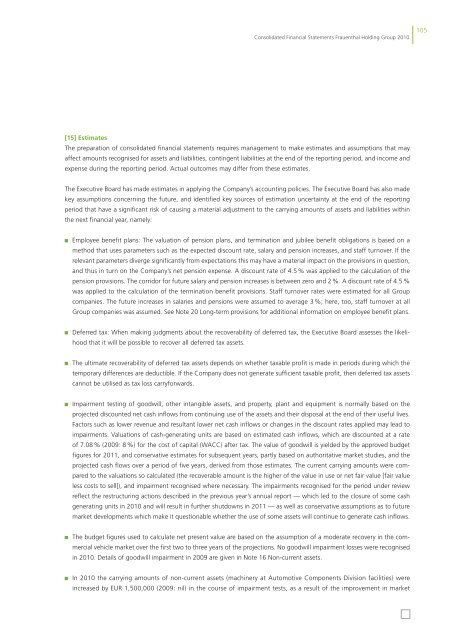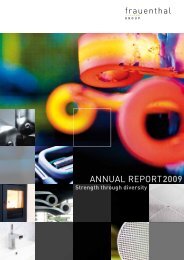Annual Report 2010 - Frauenthal Holding AG
Annual Report 2010 - Frauenthal Holding AG
Annual Report 2010 - Frauenthal Holding AG
Create successful ePaper yourself
Turn your PDF publications into a flip-book with our unique Google optimized e-Paper software.
Consolidated Financial Statements <strong>Frauenthal</strong> <strong>Holding</strong> Group <strong>2010</strong><br />
[15] Estimates<br />
The preparation of consolidated financial statements requires management to make estimates and assumptions that may<br />
affect amounts recognised for assets and liabilities, contingent liabilities at the end of the reporting period, and income and<br />
expense during the reporting period. Actual outcomes may differ from these estimates.<br />
The Executive Board has made estimates in applying the Company’s accounting policies. The Executive Board has also made<br />
key assumptions concerning the future, and identified key sources of estimation uncertainty at the end of the reporting<br />
period that have a significant risk of causing a material adjustment to the carrying amounts of assets and liabilities within<br />
the next financial year, namely:<br />
Employee benefit plans: The valuation of pension plans, and termination and jubilee benefit obligations is based on a<br />
method that uses parameters such as the expected discount rate, salary and pension increases, and staff turnover. If the<br />
relevant parameters diverge significantly from expectations this may have a material impact on the provisions in question,<br />
and thus in turn on the Company’s net pension expense. A discount rate of 4.5 % was applied to the calculation of the<br />
pension provisions. The corridor for future salary and pension increases is between zero and 2 %. A discount rate of 4.5 %<br />
was applied to the calculation of the termination benefit provisions. Staff turnover rates were estimated for all Group<br />
companies. The future increases in salaries and pensions were assumed to average 3 %; here, too, staff turnover at all<br />
Group companies was assumed. See Note 20 Long-term provisions for additional information on employee benefit plans.<br />
Deferred tax: When making judgments about the recoverability of deferred tax, the Executive Board assesses the likelihood<br />
that it will be possible to recover all deferred tax assets.<br />
The ultimate recoverability of deferred tax assets depends on whether taxable profit is made in periods during which the<br />
temporary differences are deductible. If the Company does not generate sufficient taxable profit, then deferred tax assets<br />
cannot be utilised as tax loss carryforwards.<br />
Impairment testing of goodwill, other intangible assets, and property, plant and equipment is normally based on the<br />
projected discounted net cash inflows from continuing use of the assets and their disposal at the end of their useful lives.<br />
Factors such as lower revenue and resultant lower net cash inflows or changes in the discount rates applied may lead to<br />
impairments. Valuations of cash-generating units are based on estimated cash inflows, which are discounted at a rate<br />
of 7.08 % (2009: 8 %) for the cost of capital (WACC) after tax. The value of goodwill is yielded by the approved budget<br />
figures for 2011, and conservative estimates for subsequent years, partly based on authoritative market studies, and the<br />
projected cash flows over a period of five years, derived from those estimates. The current carrying amounts were compared<br />
to the valuations so calculated (the recoverable amount is the higher of the value in use or net fair value [fair value<br />
less costs to sell]), and impairment recognised where necessary. The impairments recognised for the period under review<br />
reflect the restructuring actions described in the previous year’s annual report — which led to the closure of some cash<br />
generating units in <strong>2010</strong> and will result in further shutdowns in 2011 — as well as conservative assumptions as to future<br />
market developments which make it questionable whether the use of some assets will continue to generate cash inflows.<br />
The budget figures used to calculate net present value are based on the assumption of a moderate recovery in the commercial<br />
vehicle market over the first two to three years of the projections. No goodwill impairment losses were recognised<br />
in <strong>2010</strong>. Details of goodwill impairment in 2009 are given in Note 16 Non-current assets.<br />
In <strong>2010</strong> the carrying amounts of non-current assets (machinery at Automotive Components Division facilities) were<br />
increased by EUR 1,500,000 (2009: nil) in the course of impairment tests, as a result of the improvement in market<br />
105




